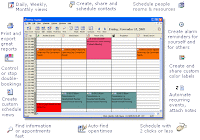 Email is a problem for everyone who is concerned with being productive. It is a new medium and there is virtually no-one with 20 years of email experience.
Email is a problem for everyone who is concerned with being productive. It is a new medium and there is virtually no-one with 20 years of email experience.
Only recently have best practices begun to be developed for this difficult source of information. In the absence of these best practices, users end up with in-boxes of thousands of emails, not knowing what to do about this problem that only increases with each passing month.
Here are the current best practices:
- Keep an empty in-box by processing every item
- Allow email to come into the in-box only at specific, planned times of day
- When faced with hundreds or thousands of backlogged email, copy them from the in-box to another folder and start with a fresh in-box
- Touch email only once
These are fine principles, and I happen to follow them as much as I can each day. It is better, however, to also understand why the in-box is such a problem.
The problem can be understood at the level of the fundamentals, rather than just as a matter of practices. A decision to accept incoming items into an in-box is an open invitation to receive everything from spam, to pictures, music, requests, replies, FYI’s — and confusing mixes of all the above and more. Unfortunately, they don’t come tagged as such. Instead, they are unclear and sometimes intentionally misleading in terms of their time demand on the recipient.
The first few moments after receiving an email and reading it are spent deciding what the next action should be. In other words, a massive Emptying action has begun (to use the 2Time terms). This is the point at which I find myself getting stuck.
Some are easy – they are immediately deleted. Others contain important information which must be stripped from the email and stored in a safe place for future retrieval.
These are the easy emails to deal with. In terms of the 2Time fundamentals, the first are Tossed while the second are Stored and Tossed.
The vast majority of email, however, is more complex. Some represent actions that need to be immediately Listed or Scheduled. The most troublesome present dilemmas – the next action is not immediately apparent and requires some thought.
And here is the decision that kills most people: emails that are important but need further thought are left in the in-box, “so they don’t get forgotten”. This is not a problem when there are 1-2 such emails per day. However, increase that number to 10 emails per day requiring a few days of thought each, and in no time chaos ensues.
That initial, innocent practice ends up drowning the user who has no idea how to change course. The result is one we can all recognize in other people. There are some professionals who are simply incapable of responding to all their email. More often than not, important things fall through the cracks. They are not ill-intentioned… it’s just that their habits are ill-suited for the volume of time demands coming at them via email.
The solution is an upgrade of several practices, and then implementation of Warning and Reviewing practices to prevent breakdowns and to help evolve the system continuously.
Also, the following practices must be upgraded:
- Listing – a folder or category must be created to be able to store all items that are under consideration (a Thinking About List) and items that are awaiting further action or information by others (a Waiting For List).
- Scheduling – for these lists to work, however, they are best accompanied by scheduled times at which these lists are processed. Furthermore, these scheduled need to have alarms to ensure that they are indeed processed.
Also, items that require dedicated thinking or meeting time should be scheduled in the calendar immediately. For example:
Tuesday, October 23rd from 2:00 – 2:30 p.m. – Decide on how to respond to email from Mark.
In this way, it is much easier to accomplish the empty in-box. Several habits may have to be upgraded at the same time in order to get to that point, but these upgrades must happen all together for the objective of an empty in-box to be achieved. Once achieved, the higher belt users never allow their in-boxes to hold more than a screenful of items at a time, and they learn to empty it as soon as they can each day.
The essential habit to be broken is one that was learned in childhood – to remember to do stuff, I need to put it where I can see it. In other words, we learn to use the physical presence as a reminder.
Again, this isn’t a problem when the number of items is small. As the number grows, it becomes an impossible practice to maintain, leading to cluttered room, desk and in-box.
Using the practices of Listing and Scheduling are ways to reliably deal with large numbers of time demands – in fact, they are the only ways.
 One of the things that I wished Outlook would do intelligently is to link the contents of a time slots with the next logical time slot.
One of the things that I wished Outlook would do intelligently is to link the contents of a time slots with the next logical time slot.





 Scheduling is one of the major activities that take place in any time management system.
Scheduling is one of the major activities that take place in any time management system.